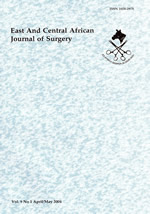
|
East and Central African Journal of Surgery
Association of Surgeons of East Africa and College of Surgeons of East Central and Southern Africa
ISSN: 1024-297X
EISSN: 1024-297X
Vol. 16, No. 2, 2011, pp. 72-79
|
 Bioline Code: js11032
Bioline Code: js11032
Full paper language: English
Document type: Research Article
Document available free of charge
|
|
|
East and Central African Journal of Surgery, Vol. 16, No. 2, 2011, pp. 72-79
| en |
Typhoid Intestinal Perforations in a Tropical Tertiary Health Facility: A Prospective Study.
Tade, A.O.; Olateju, S.O.; Osinupebi, O.A. & Salami, B.A.
Abstract
Background: Despite decades of improvement in patient care globally, typhoid intestinal perforation remains a frequently fatal illness in the developing world. This study aimed at determining the factors that influenced the outcome of surgical management typhoid intestinal perforation in Sagamu, South-West Nigeria.
Methods: Twenty-three consecutive adult cases managed between January 2006 and December 2008 at the surgical department of Olabisi Onabanjo University Teaching Hospital Sagamu were studied prospectively. Patients received parental ciprofloxacin or ceftriaxone in addition to metronidazole. They all had laparotomy after adequate resuscitation. Patients in American Society of Anesthesiologists (ASA) class VE were operated upon under local anaesthesia, intravenous ketamine and diazepam.
Results: There were 13 males and 10 females with a male to female sex ratio of 1.3:1. The ages ranged from 19 to 51 years. Seventeen (73.9%) patients were aged between 20 and 34 years. Two patients, one each from ASA grades IVE and VE, died on 1st and 2nd postoperative days respectively. The mortality of 8.7% was significantly associated with ASA class (P= 0.040). ASA class was strongly associated with severity of peritonitis (P=0.021). Complications occurred in 11 (47.8%) patients. Ten (43.5%) developed wound infection and one (4.3%) an entercutaenous fecal fistula. Wound infection was significantly associated with method of closure of perforation (P=0.034), and number of perforations (P=0.007).
Conclusion: This study has shown that ASA class is a significant predictor of mortality in patients treated for typhoid intestinal perforation in our centre. We recommend that patients in ASA classes IV and V should have post-operative intensive care to reduce the risk of death.
|
| |
© Copyright 2011 - East and Central African Journal of Surgery
|
|
